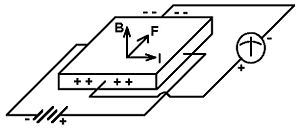Free electron model of metals: Difference between revisions
MatthewHoza (talk | contribs) |
MatthewHoza (talk | contribs) |
||
| Line 121: | Line 121: | ||
<math>\psi(x,y,z) = \frac{1}{V^{\frac{1}{2}}} e^{i \mathbf{k} \cdot \mathbf{r}} = \frac{1}{V^{\frac{1}{2}}} e^{(k_x x + k_y y + k_z z)}</math> | <math>\psi(x,y,z) = \frac{1}{V^{\frac{1}{2}}} e^{i \mathbf{k} \cdot \mathbf{r}} = \frac{1}{V^{\frac{1}{2}}} e^{(k_x x + k_y y + k_z z)}</math> | ||
where <math>V = L^3</math> and <math>V^{-\frac{1}{2}}</math> is to normalize the wave-function. | |||
'''Maybe someone who has taken quantum can elaborate on the explanation above?'''' [[User:MatthewHoza|MatthewHoza]] 14:35, 29 April 2009 (EDT) | '''Maybe someone who has taken quantum can elaborate on the explanation above?'''' [[User:MatthewHoza|MatthewHoza]] 14:35, 29 April 2009 (EDT) | ||
To satisfy the periodic boundary conditions the allowed wave-vectors must be: | |||
<math>k_x = \frac{2\pi p}{L} \ \ \ k_y = \frac{2\pi q}{L} \ \ \ k_z = \frac{2\pi r}{L}</math> | |||
where <math>p, q,</math> and <math>r</math> are integer values. This corresponds to an energy | |||
<math>\epsilon = \frac{\hbar^2 k^2}{2m} = \frac{\hbar^2}{2m}(k_x^2 + k_y^2 + k_z^2)</math> | |||
and a momentum | |||
<math>\mathbf{p} = \hbar\mathbf{k} = \hbar(k_x, k_y, k_z)</math> | |||
==Sommerfeld (quantum) theory for free electrons== | ==Sommerfeld (quantum) theory for free electrons== | ||
Revision as of 14:42, 29 April 2009
“ Freedom's just another word for nothing left to lose, ” - Janis Joplin
| ||||||
The free electron model is a simple model for the behavior of valence electrons in a crystal structure of a metallic solid. It was developed principally by Arnold Sommerfeld who combined the classical Drude model with quantum mechanical Fermi-Dirac statistics. Given its simplicity, it is surprisingly successful in explaining many experimental phenomena, especially
- the Wiedemann-Franz law which relates electrical conductivity and thermal conductivity;
- the temperature dependence of the heat capacity;
- the shape of the electronic density of states;
- the range of binding energy values;
- electrical conductivities;
- thermal electron emission and field electron emission from bulk metals.
Classical Electron Model
Drude transport theory
The Drude theory assumes that movement of electrons can be described classically. The model resembles a pinball machine where the electrons accelerate, hit a scattering surface (positive ion), and then begin accelerating once more.
During the acceleration phase the velocity gained by the electron is described as:
Failed to parse (SVG (MathML can be enabled via browser plugin): Invalid response ("Math extension cannot connect to Restbase.") from server "https://wikimedia.org/api/rest_v1/":): {\displaystyle \Delta v = at = -\frac{eE}{m}t}
This gives the electron a total velocity
Failed to parse (SVG (MathML can be enabled via browser plugin): Invalid response ("Math extension cannot connect to Restbase.") from server "https://wikimedia.org/api/rest_v1/":): {\displaystyle v = v_{0} + \Delta v\!}
Then the electron scatters off a surface. The distance between scattering surfaces is called the mean free path, Failed to parse (SVG (MathML can be enabled via browser plugin): Invalid response ("Math extension cannot connect to Restbase.") from server "https://wikimedia.org/api/rest_v1/":): {\displaystyle l} .
Note that on average Failed to parse (SVG (MathML can be enabled via browser plugin): Invalid response ("Math extension cannot connect to Restbase.") from server "https://wikimedia.org/api/rest_v1/":): {\displaystyle v_0} is equal to zero since the movement is in completely random directions. So now we can calculate the average total velocity to be
Failed to parse (SVG (MathML can be enabled via browser plugin): Invalid response ("Math extension cannot connect to Restbase.") from server "https://wikimedia.org/api/rest_v1/":): {\displaystyle <v>\ =\ < v_0 + \Delta v >\ =\ <v_0> + <\Delta v>\ =\ <\Delta v>\!}
Failed to parse (SVG (MathML can be enabled via browser plugin): Invalid response ("Math extension cannot connect to Restbase.") from server "https://wikimedia.org/api/rest_v1/":): {\displaystyle <\Delta v>\ \sim \overrightarrow{E}}
Now using the equation for current
Failed to parse (SVG (MathML can be enabled via browser plugin): Invalid response ("Math extension cannot connect to Restbase.") from server "https://wikimedia.org/api/rest_v1/":): {\displaystyle \overrightarrow{j} = -ne<v> = -ne<\Delta v>\ = -\frac{ne^{2}}{m}<t>}
Here Failed to parse (SVG (MathML can be enabled via browser plugin): Invalid response ("Math extension cannot connect to Restbase.") from server "https://wikimedia.org/api/rest_v1/":): {\displaystyle <t>} is the average time between collisions, which is called the scatter time, Failed to parse (SVG (MathML can be enabled via browser plugin): Invalid response ("Math extension cannot connect to Restbase.") from server "https://wikimedia.org/api/rest_v1/":): {\displaystyle \tau} .
This gives us the Drude formula ,
Failed to parse (SVG (MathML can be enabled via browser plugin): Invalid response ("Math extension cannot connect to Restbase.") from server "https://wikimedia.org/api/rest_v1/":): {\displaystyle \sigma = -\frac{ne^{2}}{m}\tau} , where Failed to parse (SVG (MathML can be enabled via browser plugin): Invalid response ("Math extension cannot connect to Restbase.") from server "https://wikimedia.org/api/rest_v1/":): {\displaystyle \tau = \frac{l}{v_0}} , and Failed to parse (SVG (MathML can be enabled via browser plugin): Invalid response ("Math extension cannot connect to Restbase.") from server "https://wikimedia.org/api/rest_v1/":): {\displaystyle \sigma} is conductivity.
And from E&M recall that the resistivity of the material is:
Failed to parse (SVG (MathML can be enabled via browser plugin): Invalid response ("Math extension cannot connect to Restbase.") from server "https://wikimedia.org/api/rest_v1/":): {\displaystyle \rho = \frac{1}{\sigma} }
Also another often quoted value is the mobility, the proportionality constant between the velocity of the electrons and the electric field it is placed in, of the material which is:
Failed to parse (SVG (MathML can be enabled via browser plugin): Invalid response ("Math extension cannot connect to Restbase.") from server "https://wikimedia.org/api/rest_v1/":): {\displaystyle \mu = \frac{e\tau}{m_e} = \frac{\sigma}{ne} }
Hall effect
When a metal is placed in a magnetic field Failed to parse (SVG (MathML can be enabled via browser plugin): Invalid response ("Math extension cannot connect to Restbase.") from server "https://wikimedia.org/api/rest_v1/":): {\displaystyle \mathbf{B}} and a current density Failed to parse (SVG (MathML can be enabled via browser plugin): Invalid response ("Math extension cannot connect to Restbase.") from server "https://wikimedia.org/api/rest_v1/":): {\displaystyle \mathbf{j}} is passed through it, a transverse electric field Failed to parse (SVG (MathML can be enabled via browser plugin): Invalid response ("Math extension cannot connect to Restbase.") from server "https://wikimedia.org/api/rest_v1/":): {\displaystyle \mathbf{E_{H}}} is set up given by
Failed to parse (SVG (MathML can be enabled via browser plugin): Invalid response ("Math extension cannot connect to Restbase.") from server "https://wikimedia.org/api/rest_v1/":): {\displaystyle \mathbf{E_H} = R_H \mathbf{B} \ \times \ \mathbf{j}}
This is the Hall Effect and Failed to parse (SVG (MathML can be enabled via browser plugin): Invalid response ("Math extension cannot connect to Restbase.") from server "https://wikimedia.org/api/rest_v1/":): {\displaystyle R_H} is known as the Hall coefficient.
This effect originates from the Lorentz Force, which makes charges pile up on opposite sides of the conductor. This creates a potential difference, or Hall Voltage, within the conductor. The internal charges will continue to pile up until it is in equilibrium with the Lorentz Force.
This set up is useful because it enables us to measure the electron mobility, Failed to parse (SVG (MathML can be enabled via browser plugin): Invalid response ("Math extension cannot connect to Restbase.") from server "https://wikimedia.org/api/rest_v1/":): {\displaystyle \mu} , from measured values of Failed to parse (SVG (MathML can be enabled via browser plugin): Invalid response ("Math extension cannot connect to Restbase.") from server "https://wikimedia.org/api/rest_v1/":): {\displaystyle R_H} and electronic conductivity, Failed to parse (SVG (MathML can be enabled via browser plugin): Invalid response ("Math extension cannot connect to Restbase.") from server "https://wikimedia.org/api/rest_v1/":): {\displaystyle \sigma} .
Failed to parse (SVG (MathML can be enabled via browser plugin): Invalid response ("Math extension cannot connect to Restbase.") from server "https://wikimedia.org/api/rest_v1/":): {\displaystyle \mu = |R_H| \sigma \! }
Limitations of the classical electron model
Looking at the Drude model again and taking into account the Equipartition Theory:
Failed to parse (SVG (MathML can be enabled via browser plugin): Invalid response ("Math extension cannot connect to Restbase.") from server "https://wikimedia.org/api/rest_v1/":): {\displaystyle \frac{1}{2}mv_{0}^{2}=k_B T}
we can show that the scattering time should be proportional to Failed to parse (SVG (MathML can be enabled via browser plugin): Invalid response ("Math extension cannot connect to Restbase.") from server "https://wikimedia.org/api/rest_v1/":): {\displaystyle T}
Failed to parse (SVG (MathML can be enabled via browser plugin): Invalid response ("Math extension cannot connect to Restbase.") from server "https://wikimedia.org/api/rest_v1/":): {\displaystyle v_0 = \sqrt{\frac{2k_B T}{m}} \sim \sqrt{T}}
Failed to parse (SVG (MathML can be enabled via browser plugin): Invalid response ("Math extension cannot connect to Restbase.") from server "https://wikimedia.org/api/rest_v1/":): {\displaystyle \Rightarrow \tau \sim \frac{1}{\sqrt{T}}}
However, this is wrong since velocity is not proportional to Failed to parse (SVG (MathML can be enabled via browser plugin): Invalid response ("Math extension cannot connect to Restbase.") from server "https://wikimedia.org/api/rest_v1/":): {\displaystyle T} . When Failed to parse (SVG (MathML can be enabled via browser plugin): Invalid response ("Math extension cannot connect to Restbase.") from server "https://wikimedia.org/api/rest_v1/":): {\displaystyle T = 0} there is still quantum uncertainty.
Pauli Principle and Fermi-Dirac statistics
Fermi Dirac Probability Distribution
Failed to parse (SVG (MathML can be enabled via browser plugin): Invalid response ("Math extension cannot connect to Restbase.") from server "https://wikimedia.org/api/rest_v1/":): {\displaystyle f(E) = \frac{1}{e^{\frac{E-E_F}{k_B T}} +1} }
Schrodinger Equation for Free Electrons
Born-von Karaman boundary conditions
Fermi energy and Fermi momentum
Consider a cube of metal with sides Failed to parse (SVG (MathML can be enabled via browser plugin): Invalid response ("Math extension cannot connect to Restbase.") from server "https://wikimedia.org/api/rest_v1/":): {\displaystyle L} with faces perpendicular to x, y, and z axes. We must solve the time independent Schrodinger equation:
Failed to parse (SVG (MathML can be enabled via browser plugin): Invalid response ("Math extension cannot connect to Restbase.") from server "https://wikimedia.org/api/rest_v1/":): {\displaystyle -\frac{\hbar^2}{2m}\nabla^2 \psi = \epsilon \psi}
We can do this by imposing periodic boundary conditions such that:
Failed to parse (SVG (MathML can be enabled via browser plugin): Invalid response ("Math extension cannot connect to Restbase.") from server "https://wikimedia.org/api/rest_v1/":): {\displaystyle \psi(x + L, y + L, z+ L) = \psi(x,y,z)}
This gives us solutions of Schrodinger's equation are plane waves
Failed to parse (SVG (MathML can be enabled via browser plugin): Invalid response ("Math extension cannot connect to Restbase.") from server "https://wikimedia.org/api/rest_v1/":): {\displaystyle \psi(x,y,z) = \frac{1}{V^{\frac{1}{2}}} e^{i \mathbf{k} \cdot \mathbf{r}} = \frac{1}{V^{\frac{1}{2}}} e^{(k_x x + k_y y + k_z z)}}
where Failed to parse (SVG (MathML can be enabled via browser plugin): Invalid response ("Math extension cannot connect to Restbase.") from server "https://wikimedia.org/api/rest_v1/":): {\displaystyle V = L^3} and Failed to parse (SVG (MathML can be enabled via browser plugin): Invalid response ("Math extension cannot connect to Restbase.") from server "https://wikimedia.org/api/rest_v1/":): {\displaystyle V^{-\frac{1}{2}}} is to normalize the wave-function.
Maybe someone who has taken quantum can elaborate on the explanation above?' MatthewHoza 14:35, 29 April 2009 (EDT)
To satisfy the periodic boundary conditions the allowed wave-vectors must be:
Failed to parse (SVG (MathML can be enabled via browser plugin): Invalid response ("Math extension cannot connect to Restbase.") from server "https://wikimedia.org/api/rest_v1/":): {\displaystyle k_x = \frac{2\pi p}{L} \ \ \ k_y = \frac{2\pi q}{L} \ \ \ k_z = \frac{2\pi r}{L}}
where Failed to parse (SVG (MathML can be enabled via browser plugin): Invalid response ("Math extension cannot connect to Restbase.") from server "https://wikimedia.org/api/rest_v1/":): {\displaystyle p, q,} and Failed to parse (SVG (MathML can be enabled via browser plugin): Invalid response ("Math extension cannot connect to Restbase.") from server "https://wikimedia.org/api/rest_v1/":): {\displaystyle r} are integer values. This corresponds to an energy
Failed to parse (SVG (MathML can be enabled via browser plugin): Invalid response ("Math extension cannot connect to Restbase.") from server "https://wikimedia.org/api/rest_v1/":): {\displaystyle \epsilon = \frac{\hbar^2 k^2}{2m} = \frac{\hbar^2}{2m}(k_x^2 + k_y^2 + k_z^2)}
and a momentum
Failed to parse (SVG (MathML can be enabled via browser plugin): Invalid response ("Math extension cannot connect to Restbase.") from server "https://wikimedia.org/api/rest_v1/":): {\displaystyle \mathbf{p} = \hbar\mathbf{k} = \hbar(k_x, k_y, k_z)}

